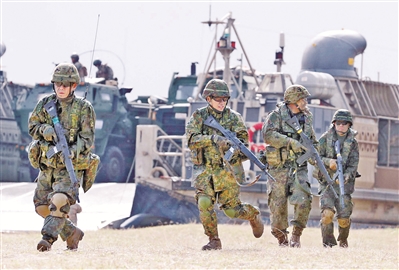
Japanese cabinet's release of three security policy documents – National Security Strategy (NSS), National Defense Strategy (NDS) and Defense Buildup Program (DBP)– on December 16 marked a sea change in the country's post-WWII security and defense strategies. Compared with before, the new defense strategy is more radical about surrounding security threats and makes aggressive strategic design and systematic deployments for future military development in two ways – strengthening counterattack capability and increasing military budget by a large margin. Such a drastic U-turn has caused doubts and worries both in Japan and the international community.
12月16日,日本内阁通过《国家安全保障战略》《国家防卫战略》《防卫力量整备计划》3份安保政策文件,标志着日本战后安保和防卫战略的“大转向”。与之前相比,日本新防卫战略对周边安全威胁的研判更加激进,从强化反击能力和大幅增加军费两方面,对其未来军备发展进行突破性战略设计和体系部署。这种“急打方向盘”的做法,引发日本国内及国际舆论的质疑和担忧。
Japan is shaking off the strategic restriction to "defense only".
战略“自卫”色彩越来越淡
The three newly revised documents have assumed a more radical tone regarding the surrounding security situation, and Japan's once again upgraded wording about the threats posed by countries like DPRK and Russia is just an excuse for its strategic shift. On that basis, its new defense strategy displays three marked changes.
从内容基调看,新修订的3份文件对周边安全态势判断更为激进。此次日本再次升级了针对朝鲜、俄罗斯等国威胁的表述,意在为战略转向找借口。基于此,日本新的防卫战略呈现出三个显著变化。
First, it is more outspoken about military capacity building. The NDS makes it clear that JSDF must have the capability of counterattack and sustained operation, and allows JSDF to acquire stand-off defense capabilities that will enable it to directly attack military targets on an enemy state's territory from outside its defense zone. This officially legitimizes through a state policy the so-called "preemptive attack capability" that the Japanese defense circle has been dreaming about.
一是能力建设指向更加露骨。《国家防卫战略》明确提出自卫队要具备“反击能力”和“持续作战能力”。文件还允许自卫队拥有“防区外防御能力”,可以从敌防御区以外直接攻击其领土和军事目标。这意味着,日本防卫界梦寐以求的所谓“先敌打击能力”正式得以官方化、国策化。
Second, defense budget increases more drastically. The DBP has increased the total defense budget for the next five years to 43 trillion Yen (about US$313.4 billion), up almost 60% from the previous five years. When outlining the weapon and equipment development plan, the document asks the JSDF to gradually deploy the modified Type 12 missiles with a firing range of more than 1,000km and the US-made JASSM stealthy cruise missile, purchase more than 500 US Tomahawk cruise missiles, and build seven shore-to-ship missile regiments, two hypersonic missile battalions, and two long-range missile combat units.
二是国防预算增长更为激进。《防卫力量整备计划》将未来5年防卫费预算总额提高为43万亿日元(约合3134亿美元),相较于上一个五年的总额,涨幅接近60%。在武器装备发展规划上,文件要求自卫队逐步部署改进型12式导弹(射程超过1000公里)、美制JASSM隐形巡航导弹,并采购超过500枚美制“战斧”巡航导弹,同时还将新建7个岸舰导弹团、2个高超音速导弹营和2个远程导弹作战单元。
Third, Japan is more eager to develop combat capabilities in emerging domains. The NSS stresses that Japan will intensify its combat deployments in emerging domains such as space warfare, cyber warfare, and electromagnetic warfare, with a special focus on advancing its cyber defense capability to be commensurate with that of western powers and introducing proactive cyber defense terms.
三是新兴领域建设更为迫切。《国家安全保障战略》强调,日本将加强在太空作战、网络战和电磁作战等新兴领域的作战部署,重点将网络防御能力建设提升至 “与西方大国相当水平”,引入“主动网络防御条款”。
Japan is moving faster toward "independent defense".
“自主国防”步伐越来越快
Japan's about-face in defense policy is ultimately aimed to smash the restrictions imposed upon it by the post-WWII order and realize the so-called "independent defense", as reflected in three tendencies.
日本此次防卫政策“大转向”,其最终目标是彻底突破战后秩序束缚,实现所谓“自主国防”,这集中体现在三个倾向上。
To begin with, Japan takes the opportunity of releasing the three documents to elevate its previous tricks of breaking through restrictions and expanding the military into a national strategy. For many years, the Liberal Democratic Party and Japanese defense circle have been clamoring about benchmarking Japan's defense spending against the NATO standard of 2% of GDP and developing the JSDF's capability to attack enemy bases. Now the three documents have elevated the LDP's internal consensus into a national strategy, aiming to unify the mind at home in order to coordinate resources for future military buildup.
首先,借机将此前谋求突破束缚、扩充军备的诸多小动作上升为国家战略。此前,日本自民党与防卫界经年累月炒作日本防卫费要对标北约达到占GDP2%规模,自卫队应发展“对敌基地攻击能力”等等。此次日本通过3份文件,将自民党内部共识抬升为国家战略,其最大用意在于统一国内思想,统筹未来军备建设资源。
Secondly, Japan is seeking to realize "independent national defense" under the pretext of responding to America's "bloc confrontation" ploy. It not only imitates the US in naming the NSS and NDS but also follows its steps in determining security threats and borrows its words to describe the threats it thinks imposed by surrounding countries, all to gain the big brother’s favor. It's easy to see that Japan, observing the logic that "America's enemy is my enemy", will continue to develop its military in the name of answering to the ally's demand and take advantage of the blurred line to quickly move toward its goal of "independent defense".
其次,以响应美国“阵营对抗”思想为名,谋取实现“自主国防”之实。《国家安全保障战略》《国家防卫战略》不仅名称效仿美国,在威胁判断上更是紧跟美国节奏,对周边主要国家的威胁定位用词照搬美式风格。这种做法显然有利于讨取美国“欢心”。不难预料,今后日本将继续基于“美国的敌人就是我的敌人”的逻辑判断,以呼应盟友诉求为名发展军备,利用模糊空间朝着“自主国防”的目标快速迈进。
Thirdly, although Japan has only made sporadic breakthroughs in certain areas of its defense policy, the tendency nurtures a systemic adjustment. Today, it succeeds in making a substantive breakthrough regarding the massive increase in the defense budget and development of counterattack capability; tomorrow it can shake off other restraints as well. Once the bottom line is crossed, its bloating military ambition will take Japan’s defense strategy further astray.
再次,尽管日本防卫政策目前看来仅在部分领域实现了点状突破,实则却孕育着体系调整的征兆。日本此次在防卫费预算增长和对敌进攻能力上实现了质的突破,今后亦可推动摆脱其他“束缚”和制约机制。一旦底线性制度被突破,不断膨胀的军事野心将引发日本防卫战略出现更进一步的“转向”。











